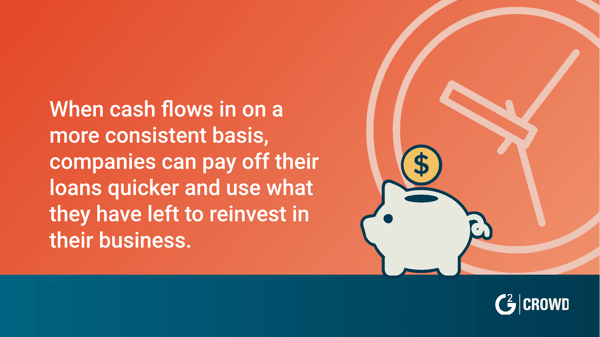While there are plenty of ways to set up a billing cycle, such as using billing software or accounting software, some businesses don’t know how to take the necessary steps to establish one.
Studies have shown 82 percent of small businesses fail due to cash flow problems. What you might not know is this can happen even if companies are producing a profit.
The main reason is these companies are more focused on if money is coming in, not when money is coming in. Certainly, companies bill for services and goods they provide, but if they aren't getting paid until after they pay off their own monthly bills, the result is a serious cash flow problem.
This is why your company needs to establish a billing cycle. A billing cycle is the best way to ensure your company receives income on a consistent basis so it can make loan payments and meet other financial obligations.
What is a billing cycle?
Billing cycle definition
The billing cycle is the period of time from the end of one billing statement to the start of the next. The billing statement is a request for payment that one business or individual sends another for services and goods provided on a recurring basis.
Perhaps the most relatable example of a billing cycle is a credit card billing cycle. Credit card companies usually set up a monthly billing cycle with a customer and send them a billing statement the same day every month. It contains their statement balance and they’re given a short grace period to make payments before incurring a late payment penalty.
The same concept of the credit card billing cycle applies to any business that must request payments on a recurring basis. Hospitals, for example, use medical billing cycles to bill patients after treatment because most patients cannot paya full billing statement up front. Patients pay their bills over a long period of time to ensure that they pay off their debt.
In the business world, it’s a good idea to implement a billing cycle so your clients understand how often they need to make payments. This will have a positive effect on your cash flow, as your company will receive payments on a more consistent basis.
How to set up a billing cycle
Setting up a billing cycle is easy when you follow these steps:
Create a new cycle name
Whenever you’re creating a billing cycle it’s important to clearly define the name of the billing cycle so both you and your client can easily identify what it applies to. For example, a soda supplier may send 50 packs of soda to a grocery store every two weeks. The soda would be clearly labeled, and the billing cycle would be titled appropriately so the grocery store understands why they’re paying this company.
Select whom to bill
If your company realizes it’s making recurring requests for payment to another business, it makes sense to include that company in a recurring billing cycle. Often, companies catch on too late and don’t establish a billing cycle until years after establishing consistent payments with other businesses. This should be avoided as it can give the other businesses a large window to make their payments. So when you're deciding who to bill, look to clients you already have an established a business rapport with.
Select what you are billing for
Sometimes there are items that can be billed on an automated basis. Referring to the example of the soda supplier, that business can automate its soda payments to the grocery store because it understands this happens on a semi-monthly basis. Make sure to add companies to the billing cycle whenever they request more product, as it makes it easier for them to complete payments all at once.
Select how often you will bill
This is the most vital step, as it’s the main function that impacts your company’s cash flow. For small businesses just starting out, it might be smart to establish a shorter billing cycle so it receives payments on a more regular basis. This way it can stay cash flow positive and pay off loans on a timely basis.
Why is the billing cycle important?
There are several reasons the billing cycle is important – they are:
Improved cash flow
Companies that establish a consistent billing cycle will always see an improvement in their cash flow. In a study conducted on billing cycles, a corporation decreased its average monthly billing cycle from 17 to 10 days, meaning it billed clients every 10 days instead of every 17. While it received less money for every billing statement, it received money on a more consistent basis. The result was a reduction in billing cycle time over a five-month period, from 17 days to 9–10 days — almost a 50 percent reduction. This result satisfied customers and generated annual savings of $2.5 million.
When cash flows on a more consistent basis, companies can pay off their loans quicker and use what they have left to reinvest.
| TIP: To learn more ways to improve cash flow, check out our article on how to keep a positive cash flow all year round |

Better client satisfaction
Establishing a routine billing cycle with each client will allow them to set aside the money they need to pay your business. This way there are no surprise billing statements and they’ll know what to expect. Failing to establish a routine billing cycle often results in late payments and negative cash flow.
Accounting automation
As a general rule, the more your company can automate, the better. When your company establishes a billing cycle, it can use accounts payable automation software to automate the recurring billing statement. This way, no accountants have to worry about remembering to bill their clients and they know they’ll receive payments on a consistent basis.
Takeaways:
Establishing a billing cycle can have a variety of positive effects on your company's finances, including better cash flow and more satisfied clients.
Once you’ve established a list of clients you’d like to generate billing cycles for, you can choose the best billing software for your business. This will help automate your billing cycles, so you won’t have to worry about them anymore.
Ready to learn more about accounting?
Check out the ins and outs of the accounting cycle and the best free accounting software solutions for 2019!
 by Sujan Patel
by Sujan Patel
 by Pelli Papoulidou
by Pelli Papoulidou
 by Jazmine Betz
by Jazmine Betz